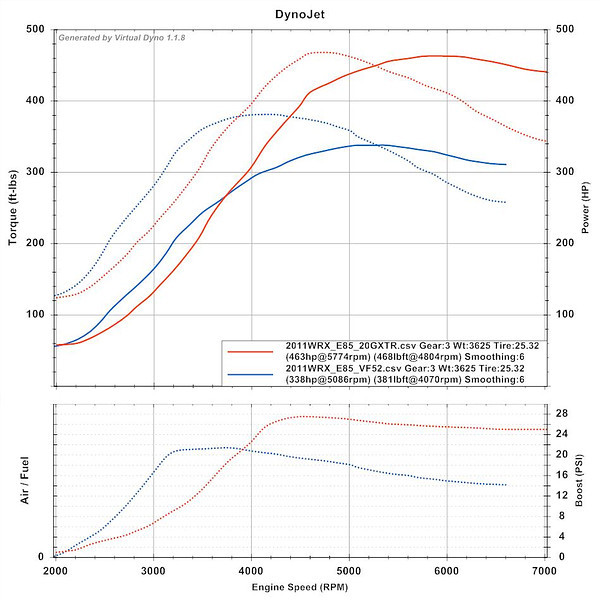You must be logged in to rate content!
5 minute(s) of a 643 minute read
8-4-2012
Here are my results using Virtual Dyno vs. the actual Dynojet at MAPerformance. I have two different setups that I've had dyno'd at MAP. The first was with the stock VF52 (on E85) and the second one was the 20G XTR (on E85). Here is more info on the 20G XTR setup if anyone is interested.
http://forums.nasioc.com/forums/show....php?t=2338819
2011 WRX - VF52 - E85:
Dynojet (MAPerformance): 339WHP
Virtual Dyno (Dynojet): 338WHP
2011 WRX - 20GXTR - E85:
Dynojet (MAPerformance): 462WHP
Virtual Dyno (Dynojet): 463WHP


The peak horsepower results are VERY close! The peak torque is different by about 5%, but the overall curves (both power and torque) look very similar. The main issues I see with people posting Virtual Dyno results are the following:
- Fast Polling turned on when logging
- Road is not flat
- Data is not entered correctly (weight, tire size, etc.)
- Improper smoothing
- Improper trimming
As long as you give Virtual Dyno good data, it will produce good results. While dyno numbers don't mean much, I've found it to be very useful to track the changes I've made to my car. I find that it's definitely more useful than the old "butt dyno". 
The other interesting comparison here (for some people) is the stock turbo vs. a bit larger one, the 20G XTR. This size (very similar to the Dom 1.5XTR) is something that many people probably consider when looking at stock location turbos and I haven't seen too many direct comparisons. I haven't seen too many people push this size turbo to higher boost (many are often run at 20-24psi), so often the results are not that impressive. When TopSpeed did the Dom1.5XTR testing, they pushed the turbo to similar boost and had great results as well.
What I glean from looking at these plots is that you can gain over 100WHP and 100WTQ when going from a stock turbo to this size turbo. You will probably lose up to 500rpm's of spool (ie. RPM @ 20psi) but peak torque will shift by nearly 1k rpm's. Often when you see turbo's this size having peak torque only about 500rpm's later than a stock turbo, it is because they are only pushing it to just over 20psi. When you push the boost higher you will typically see spool up at the same RPM but the peak will be further right.
On the street it feels great, but it does hit later. There is gobs and gobs more power, but you do have to wait for it. Downshifting does wonders. It's much easier to stay out of boost, but when you get on it, it really moves. I love the setup and could never see myself going back, but be warned that it does feel different. No more flooring it at 3k and zipping away. You're better off downshifting, then flooring it, and then zipping away much faster  I daily drive this car, and I love it. Plenty of usable power, and it comes on quick enough to be good for daily use.
I daily drive this car, and I love it. Plenty of usable power, and it comes on quick enough to be good for daily use.
The stock turbo on E85 is an absolute blast compared to a bone stock car. Spools the same or sooner, and has so much more power and especially torque. The boost still drops off by redline, but you can get a very good midrange torque peak. The car will spool so fast for the power you can make. This is a great setup and tons of fun. It is very cheap to do, and it should be quite reliable as well. If you want more power, I would wholeheartedly suggest going through stages, rather than just jumping to something big and laggy because you want a big dyno number. You'll learn a lot more about what you really want along the way.
Of course I'm sure there will be people who want to nit pick one thing or another in this post. These are just my thoughts on my results. I'm sure some people have spooled earlier or later, and some have made more or less power. This is what I've seen, and it's just one example. The only other word of warning is that with this power, things break. I've cracked a piston and shredded 3rd gear in the last year (but now I have a built motor and built tranny, so hopefully things last!).